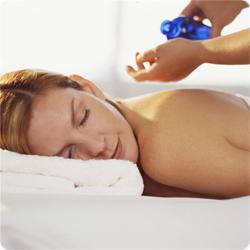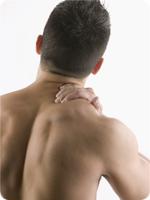Are you one of those people who always thought that getting a massage was an extravagance, or that it was just too self-indulgent and a waste of money? You might be surprised to find that a massage has many physical, mental and emotional benefits, and really isn’t all that expensive. However, perhaps you’ve just always been too busy or shy to try a professional massage, but would like to experience the benefits. You can practice some simple, self-massage techniques at home that can have great benefit in releasing tension and promoting relaxation.
Other health benefits of massage include:
- Massage calms the nervous system and promotes a sense of well-being.
- Massage improves blood circulation, which delivers oxygen and nutrients to the cells.
- Massage stimulates the lymphatic system, which carries away the body’s waste products.
- Massage prevents and relieves muscles cramps and spasms.
- Massage therapy can also help with pain management in conditions such as arthritis, sciatica, and muscle spasms.
Do Self-Massage
The great thing about self-massage is that you can practice it anytime and almost anyplace. Remember to be gentle and go slow. Pressing hard is not always necessary. Massage should feel good and relax you. Here are some simple techniques for different areas of the body:
- Tense shoulders – reach one arm across the front of your body to your opposite shoulder. Using a circular motion, press firmly on the muscle above your shoulder blade for a minute or two, then repeat on the other side. If it still feels tense, repeat these actions a second time.
- Sinus pain and pressure – place your fingertips at the bridge of your nose. Slowly slide your fingers down your nose and across the top of your cheekbones to the outside of your eyes. Repeat this several times with your eyes closed.
- Headache behind the eyes – close your eyes and place your ring fingers directly under your eyebrows, near the bridge of your nose. Slowly increase the pressure for 5-10 seconds, then gently release. Repeat 2-3 times.
- Tension headache – place your thumbs behind your ears while spreading your fingers on top of your head. Move your scalp back and forth slightly by making circles with your fingertips for 15-20 seconds.
- Foot massage - sit up straight in a chair, rest one foot on the opposite leg. While holding your foot with one hand, stroke the top of your foot with the other hand moving from the ankle area to the toes and repeat several times. Then massage the underside of your foot in the same way. Make a fist and with a circular motion move along the sole of your foot several times. Stretch and squeeze each toe and then stroke the entire foot again with smooth motions. Give your other foot the same treatment.
- Leg massage – Sit on the floor (or on a chair) with your foot flat and bend your knee. Mold your hands to the shape of your leg at the ankle and stroke and knead upward all the way up the thigh and then repeat 4 or 5 times. The gentle kneading helps to improve the shape, look and texture of your skin by improving circulation. If your muscles are sore, this will help relax them. Repeat process with your other leg. This can be done with or without massage oil.
- Arm massage – First, mold your hand around your wrist and stroke firmly and smoothly from wrist to shoulder several times making sure to massage the top and underside of your arm. Then knead the arm by squeezing and releasing, paying special attention to the fleshy area on the back of your upper arm. Follow this with firm stroking again.
- Hand massage – Start by stroking firmly the back of your hand from fingers to wrist and then gently glide back 3 to 4 times. Then squeeze the hand all over, pressing between the palm and fingers. Squeeze each finger individually and then gently stretch it before going to the next. Finally, with your thumb, apply light pressure all around the palm of your hand and wrist. Repeat process with your other hand, and finish by letting both arms hang at your sides for a moment and stretching your fingers/hands wide a few times.
- Progressive muscle relaxation – You can use this on every muscle in your body and it’s simple to do. Find a comfortable place to sit, close your eyes and take several deep breaths. Start by tightening the muscles in your hands by clenching a tight fist, hold for 5 counts and then release. Try this with other areas (such as squeezing your eyes shut, tighten your shoulders, clench your jaw, etc.) and feel the difference between a tight and a relaxed muscle. As you do this all over your body, focus on tightening each area and then letting go of the tension. Finish by taking several more deep breaths and enjoy a new sense of relaxation.
- Acupressure technique – if you have tender spots or areas of pain, try pressing, holding and then releasing with your thumb or finger on these spots several times each day. If the tenderness does not subside after a few days, check with your healthcare provider. There are times when massage is not good for you – if you have a fever, infection or inflammation. Gentle self-massage is alright, but check with your doctor if you have osteoporosis before going for a professional massage.
Try these techniques and discover how much stress and pain you can unload in just minutes a day and if you need more reasons, regular massage stimulates the lymph system and minimizes the appearance of cellulite. When you’re too busy to find a quiet, private place to do your massage, try doing some of it while watching TV or talking on the phone.
Making Your Own Massage Oil
Of course, you can buy massage oils at a variety of stores, but it is sometimes fun to make your own, plus the fact that you will know exactly what is in it when you’re finished. Thicker oils may be better for cold seasons while lighter oils will be better for the warm seasons. You need to take into consideration also if you have oily, dry or sensitive skin. Base oils and essential oils can be found at health food stores as well as online. The sandalwood massage oil recipe is a good choice for relaxation as it induces a feeling of deep peace. Below are four great choices for your base oil.
Choose a base oil:
- Jojoba Oil
- Grapeseed Oil
- Safflower Oil
- Sweet Almond Oil
Recipe for Sandalwood Massage Oil:
1. Measure 8 tsp. of one of the above base oils into a dark glass bottle with a tight-fitting lid. Grapeseed is an odorless oil base perfect for massage, however, safflower and almond oils are also great base oils. The jojoba oil closely resembles human sebum and our skin accepts it very well without threat of breakouts or reactions. If you're oily or combination skinned and afraid of putting any oil on your face, rest easy. Jojoba oil actually helps to balance skin's sebum, so it moisturizes dry skins and eases the oil production in oily skin.
2. Next, add six drops of sandalwood essential oil to the bottle. Sandalwood is a natural skin moisturizer but also calms and soothes the mind and body. With a pleasant woody aroma, sandalwood has been used for thousands of years in incense, perfume and natural remedies.
3. Place two drops of myrrh essential oil to the massage oil mixture. Myrrh is a healing oil that nourishes mature skin, helps to heal wounds and can relieve cold symptoms. A perfect blend with calming sandalwood, myrrh is said to help clear emotional blockages and alleviate mild depression.
4. Add two drops of jasmine. Jasmine is not only a popular perfume fragrance, it also helps to heal dry, sensitive skin, helps treat muscles spasms and is a mild natural sedative, the perfect additive to your calming sandalwood massage oil.
5. Close the bottle tightly and shake. Allow the mixture to settle for at least 12 hours before using, shaking the bottle gently before use.
There are many books at the library and at bookstores that are dedicated to homemade massage oil recipes. Also, online you can find a wealth of information on making your own massage oils for any type of massage.





